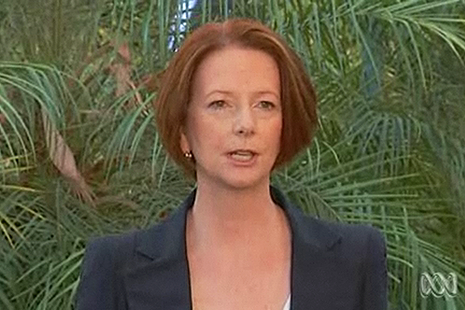IT MIGHT well have been her finest hour – but the hour comes late in the day. A poised, forthright and confident Julia Gillard responded to the challenge from Kevin Rudd – saying, in effect, bring it on – when she announced a ballot for the leadership next Monday. Displaying characteristic grace under pressure, the prime minister at last explained to the Australian people what they have long needed to know – and the fact of their not knowing has continued to dog her leadership. Why did she take part in the overthrow of Rudd in 2010?
Rudd’s continuing approval rating with the public exemplifies the disconnect between the political arena and the electorate outside it: the public sees the smiling, articulate politician, cruelly cut down by a combination of faceless men and Lady Macbeth, whereas those on the inside know only too well the self-serving deviousness and organisational dysfunctionality that characterised Rudd’s period in office.
That Gillard had never explained those fast moving events of mid-2010, and specifically her role in them, has cast her in the role of assassin, yet at her media conference in Adelaide today she laid out the process, and more importantly the reasons behind the leadership change. It was plausible, compelling and reasonable.
Why had she not done so before? Very humanly – but perhaps mistakenly – she had acted out of respect for her wounded predecessor. She also made it clear for the first time that the 2010 election campaign was “sabotaged.” Damaging leaks from cabinet repeatedly forced the government to defend itself when it should have been campaigning. It was common knowledge in Canberra where those leaks were coming from.
In what is probably the opening volley in what promises to be the longest election campaign ever, she ranged over the significant reforms enacted by her government, deftly contrasting them with Rudd’s going to water over the emissions trading scheme.
But while the prime minister showed herself in fighting mode, little will be resolved next Monday. Leadership challenges in Australia often follow a pattern of an initial assault followed by retreat, regrouping and a final assault that succeeds. It happened with Malcolm Fraser against Bill Snedden in 1975, Bob Hawke against Bill Hayden in 1982–83 and Paul Keating against Bob Hawke in 1991. Keating, after his first unsuccessful tilt, went to the backbench, refused to renounce his ambitions, and slowly garnered support for a final thrust at which he succeeded in December 1991.
If the Rudd challenge goes down that same path – and he declines Gillard’s offer of renunciation in the event of a failed first bid – then the next few months will be a rocky road indeed, and there will be but a single winner: Tony Abbott. •
Norman Abjorensen teaches public policy in the Crawford School of Economics and Government at the Australian National University.
Julia Gillard’s comments about the events of mid 2010 begin 10 minutes and 30 seconds into this recording of her media conference




